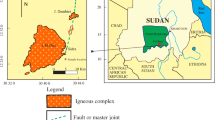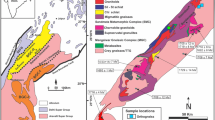Abstract
The oxygen and hydrogen isotope compositions of minerals and whole rock were determined for two types of gneiss (biotite gneiss and granitic gneiss) associated with ultrahigh pressure (UHP) eclogites in the Shuanghe district of the eastern Dabie Mountains. There are significant differences in δ18O between the two gneisses: the UHP biotite gneiss varying from −4.3‰ to 10.6‰ similar to the associated eclogites, whereas the non-UHP granitic gneiss ranges only from −3.8‰ to 1.2‰. The δD values are similar in the two gneisses with −37 to −64‰ for epidote/zoisite, −92 to −83‰ for amphibole, and −63 to −109‰ for biotite/phengite. Hydrogen isotope disequilibrium among the coexisting hydroxyl-bearing minerals is ascribed to retrograde exchange subsequent to amphibolite-facies metamorphism. Oxygen isotopic equilibrium has been preserved among various minerals in both gneisses regardless of the large variation in rock δ18O. Oxygen isotopic geothermometers yield different but regular temperatures corresponding to the closure temperatures of oxygen diffusion in the minerals. The metamorphic temperatures of both eclogite facies and amphibolite facies have been recovered in mineral pairs from the biotite gneiss. The isotopic temperatures for the granitic gneiss are mostly in accordance with amphibolite-facies metamorphism. However, high temperatures of 550 to 650 °C are obtained from those minerals resistant to retrograde oxygen isotope exchange, implying that the granitic gneiss may have experienced higher temperature metamorphism than expected from petrologic thermometers. The 18O-depletion of both gneisses is interpreted to result from meteoric-hydrothermal exchange before/during plate subduction. Therefore, the measured δ18O values of the gneisses reflect the oxygen isotope compositions of their protoliths prior to the UHP metamorphism. It is inferred that the UHP unit is in foreign contact with the non-UHP unit like a tectonic melange, but both of them experienced the two common stages of geodynamic evolution: (1) 18O-depletion prior to the UHP metamorphism, (2) uplifting since the amphibolite-facies metamorphism.
Similar content being viewed by others
Author information
Authors and Affiliations
Additional information
Received: 5 May 1998 / Accepted: 27 August 1998
Rights and permissions
About this article
Cite this article
Fu, B., Zheng, YF., Wang, Z. et al. Oxygen and hydrogen isotope geochemistry of gneisses associated with ultrahigh pressure eclogites at Shuanghe in the Dabie Mountains. Contrib Mineral Petrol 134, 52–66 (1999). https://doi.org/10.1007/s004100050468
Issue Date:
DOI: https://doi.org/10.1007/s004100050468




